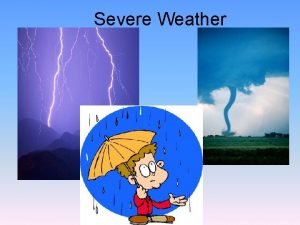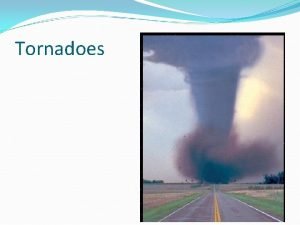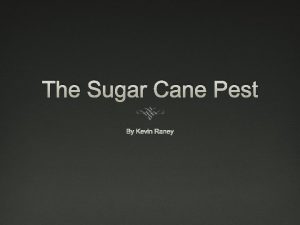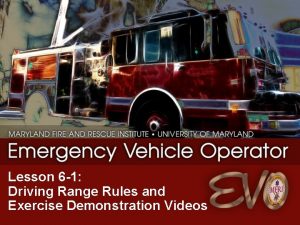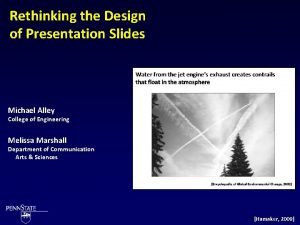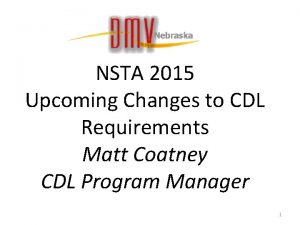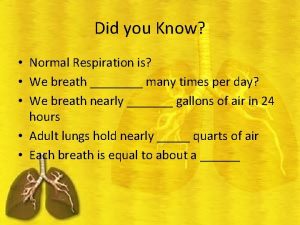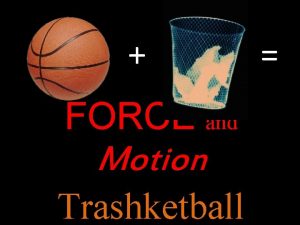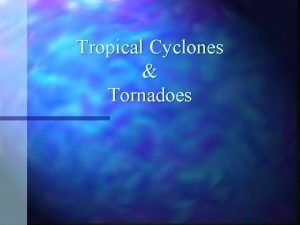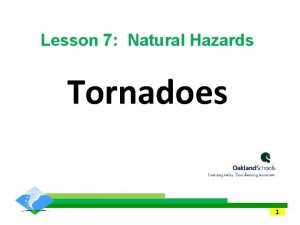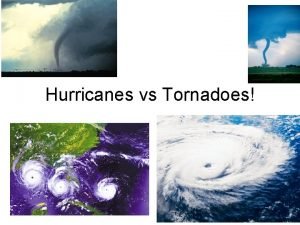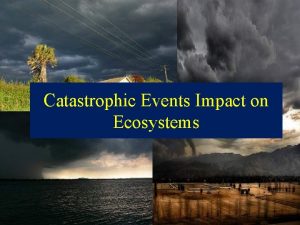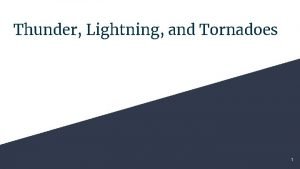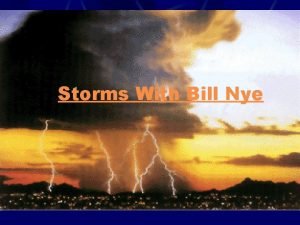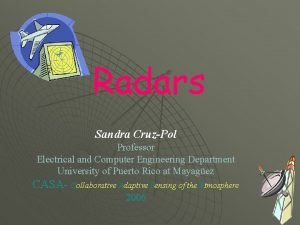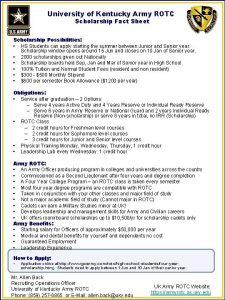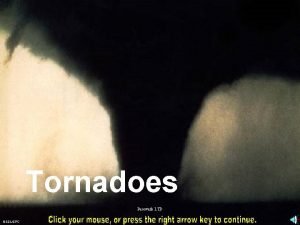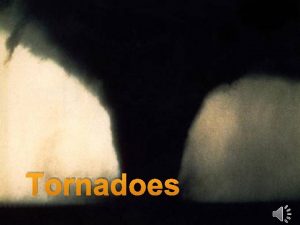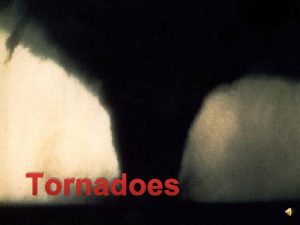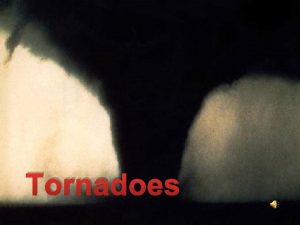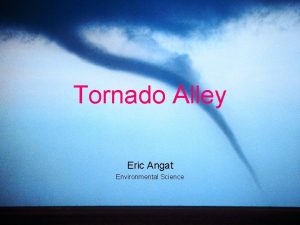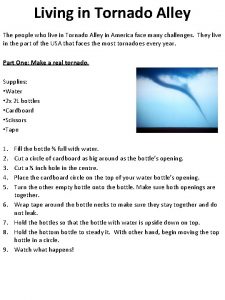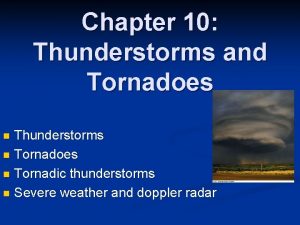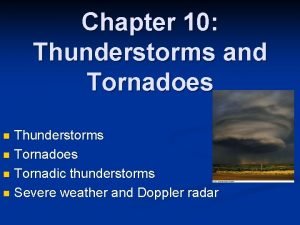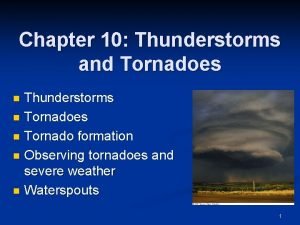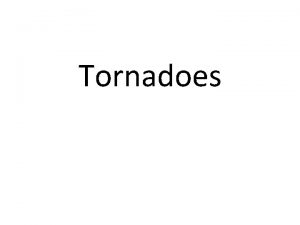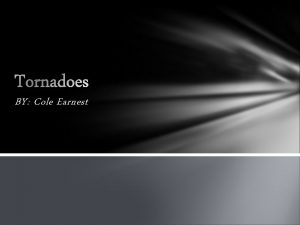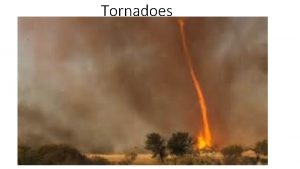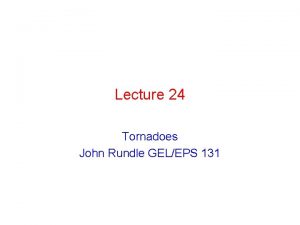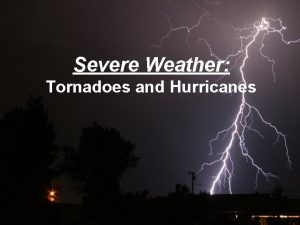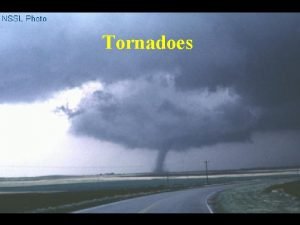tornadoes Tornado alley 32012 Kentucky tornado Trees knocked




































- Slides: 36

tornadoes


Tornado alley

3/2012 Kentucky tornado


Trees knocked down in a circular pattern









OK 837



How tornadoes form • http: //www. youtube. com/watch? v=MRykmxj. Psk&feature=related • http: //www. youtube. com/watch? v=e 17 LOS 0 Ummg&featu re=relmfu • http: //www. youtube. com/watch? v=UELQCXUKd. Zs&featu re=relmfu • http: //www. youtube. com/watch? v=Mjjw. PQRVb. Wk&featur e=relmfu

tornadoes chasers • http: //video. nationalgeographic. com/video/environment-naturaldisasters/tornadoes/tornado-samaras/ • http: //video. nationalgeographic. com/video/environment-naturaldisasters/tornadoes/samaras-tornado-missions-wcvin/ • (game) http: //www. youtube. com/watch? feature=endscreen&v=cj 0 HPni 092 E&NR=1

Notes: • Occurs: – with strong cold fronts –travel with parent thunderstorms – In tornado alley and over land short lived (minutes to 1 hr) – When c. P meets m. T – In late spring to early summer (biggest difference in temps) – Around a low pressure center Center is the vortex – may be 20 ft to 1 mile in diameter Very high winds 200 -300 mph Damage is done by high winds and flying debris VERY difficult to predict path Doppler radar has given earlier warnings (10 -15 min) Stay inside – small room w/no windows Stay in basement & under heavy objects (table/bath tube…) Stay under bridge base or in ditch

How hurricanes form • http: //www. youtube. com/watch? v=OEPZOC 6 YHUc how they form Nat’l geo • http: //www. youtube. com/watch? v=j. B 7 t 4 KKV 38 U&feature =related hurricane Katrina from space • http: //www. youtube. com/watch? v=v. BAe. Znf. MEWc&featur e=relmfu why they spin

How they form • http: //www. youtube. com/watch? NR=1&feature=endscreen&v=y 163 hw. Ey. RX 8 hurricanes form tornadoes • http: //www. youtube. com/watch? v=mr. XIb. XCufh 8&feature=relmfu why the form • http: //www. youtube. com/watch? v=k. FN 0 c. Bc. AGv. U&feature=relmfu inside the wall • http: //www. youtube. com/watch? v=Ip 6 FXe. DO 1 e 8&feature=relmfu how the eye forms

Start of a hurricane: Tropical storm

Super cell or hurricane

How the wall and eye form Wall of the storm: http: //www. youtube. com/watch? feature=endscreen&NR=1&v=k. FN 0 c. Bc. AGv. U • http: //www. youtube. com/watch? v=Ip 6 FXe. DO 1 e 8&feature=related how the eye forms • http: //www. youtube. com/watch? feature=fvwp&NR=1&v=5 i. N 352 id. Lks • http: //www. youtube. com/watch? feature=endscreen&v=bat 5 l 9 a 8 z. HM&NR=1


Winds


Frequency (season ends in Feb)

Typical paths

Storm surge

• http: //www. youtube. com/watch? v=s 76 Qn 7 bp. Cs. Q storm surge from Katrina

Notes: • Forms: – Over warm waters 25 o N to 25 o S – In late summer/early fall (ocean is warmest) NO fronts associated w/ hurricanes As ocean is heated, water evaporates Rising air creates LOW pressure centers Rising air condenses, warming the air, causing air to rise more The more the air rising, the lower the pressure gets, the stronger the updrafts are.

• Surface winds blow INTO the low • The more evaporation, the lower the pressure, the greater the wind speed • Evaporation, air rises, condensation, air warms and rises, updrafts form, surface air blows into the low. • Winds between 75 mph – 150 mph • HUGE – maybe 300 -500 miles in diameter • EYE is the center (low pressure) of rising air – calm –little winds • Long lasting 1 -2 weeks • Brings heavy rain, flooding, winds, debris, storm surges • Most damage comes from flooding – especially during high tides and spring tides. • Easier to predict path

• Evacuate inland to shelters • Stay indoors away from windows NOT IN THE BASEMENT • Board up windows/ put cars in garage…. • Bring in loose items • Boats to safe areas – deeper water or different harbor • Have extra food, water, medicines, supplies • Have battery operated radio, lights… • power may be out for days

 Kentucky tornado alley
Kentucky tornado alley Tornado alley map
Tornado alley map Gustnado vs landspout
Gustnado vs landspout Bowling rules
Bowling rules Across the alley from the wingfield apartment is the
Across the alley from the wingfield apartment is the 90 degree alley dock
90 degree alley dock Sugar cane alley analysis
Sugar cane alley analysis Michael alley penn state
Michael alley penn state What is conscience alley
What is conscience alley Alley docking
Alley docking Michael alley presentation
Michael alley presentation Alley docking tractor trailer
Alley docking tractor trailer Mullen's alley
Mullen's alley List of singular and plural
List of singular and plural Mustang alley morrisville
Mustang alley morrisville 4 step bowling
4 step bowling What is getting the wind knocked out of you
What is getting the wind knocked out of you Double grooved seam
Double grooved seam A fireman turns on a hose and is knocked backwards
A fireman turns on a hose and is knocked backwards What is compare and contrast text structure
What is compare and contrast text structure Night of the tornadoes book
Night of the tornadoes book Tropical cyclone tornadoes
Tropical cyclone tornadoes Effects of tornadoes
Effects of tornadoes Similarities of tornadoes and hurricanes
Similarities of tornadoes and hurricanes What is tornado
What is tornado Compare and contrast hurricanes and tornadoes.
Compare and contrast hurricanes and tornadoes. Tornado impact on ecosystem
Tornado impact on ecosystem What is tornado
What is tornado Cumulus mature dissipating
Cumulus mature dissipating Sandra cruz denton tx
Sandra cruz denton tx How do tornadoes affect humans
How do tornadoes affect humans University of kentucky rotc
University of kentucky rotc Blue kentucky people
Blue kentucky people Kentucky center for mathematics
Kentucky center for mathematics Testnav practice test ky
Testnav practice test ky Introduction of kfc
Introduction of kfc Kentucky labor laws salaried employees
Kentucky labor laws salaried employees

